#Vandercook
Explore tagged Tumblr posts
Text








It’s Fine Press Friday!
This Friday we highlight another book by Gaylord Schanilec and Midnight Paper Sales, out of Stockholm, WI. It’s Come to This, by Twin Cities writer Patricia Hampl, was printed in 2023, in a limited edition of 70 copies signed by Hampl, Schanilec, and Lila Shull – who drew and printed the cover lithograph of ginkgo leaves. The wood engravings are by Schanilec – the large river panorama based on a photograph by Hampl. Typefaces used include Oldrich Menhart’s Monotype Menhart,Hermann Zapf’s Michealangelo, and an italic cast by Nick Gill. Molly Brown assisted the printing “in the wilds of Western Wisconsin,” on the Vandercook Universal III. The paper was handmade in the mid-20th century, at the Velke Losiny Paper Mill in what is now the Czech Republic. According to the colophon, this was when the formula included more sizing, and the formidable paper therefore "retains its pleasing 'rattle.'" Matthew Lawler Zimmerman bound the edition at Studio Alcyon.
“Life’s a journey—no wonder it’s our most ancient metaphor. A platitude, but only truth can harden into cliché.” Written during Covid isolation at her home in St. Paul, It’s Come to This explores escape – that “Midwestern birthright, the desire to be somewhere else” – as well as the significance of a long pandemic: “At your age, a year is a serious percentage of what’s left.” With the background of Midwestern summer storms, the George Floyd protests, and menacing Boogaloo Bois, Hampl walks her dog along the Mississippi feeling both isolated from and deeply connected to the events around her. The text first appeared in The American Scholar in October of 2021. “What exactly, has come to what?” Hampl wonders to her dog. “What is this it I sigh into, what is the this I keep falling upon? What distress and what comfort does this muttered mantra express?”
Shull’s rich pattern of ginkgo leaves across the cover speaks to the dog’s favorite spot to stop along their walks. “I get it.” Hampl concludes to her companion. “And now, standing by the side of the moving water, apparently we have achieved our destination, the ghostly This.”
View more work by Gaylord Schanilec and Midnight Paper Sales.
View other Fine Press Friday Posts.
--Amanda, Special Collections Graduate Intern


#Fine Press Friday#Fine Press Fridays#finepressfriday#Midnight Paper Sales#Gaylord Schanilec#Patricia Hampl#Lila Shull#Matthew Lawler Zimmerman#Studio Alcyon#Hermann Zapf#Velke Losiny#Oldrich Menhart#Vandercook#Nick Gill#American Scholar#wood engravings#wood engravers#fine press books#letterpress printing#lithographs#color lithographs
60 notes
·
View notes
Text

❤︎✴︎swan song✴︎❤︎
9x12 linocut print, cornflower blue ink
my delicate swan ✷
i actually printed this on a vandercook letterpress, which means manyyy copies of this guy:) lmk if interested in one ❤︎
ofc its called swan song bc of lana del rey I'm not uncultured lolol
what should i print next?
#vintage#coquette#printmaking#art print#linocut#linoprint#relief print#relief carving#letterpress#vandercook#swan song#swan
14 notes
·
View notes
Text
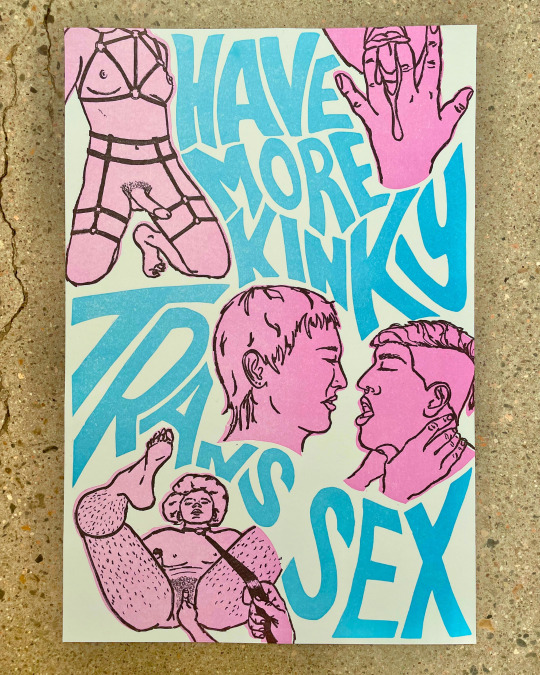
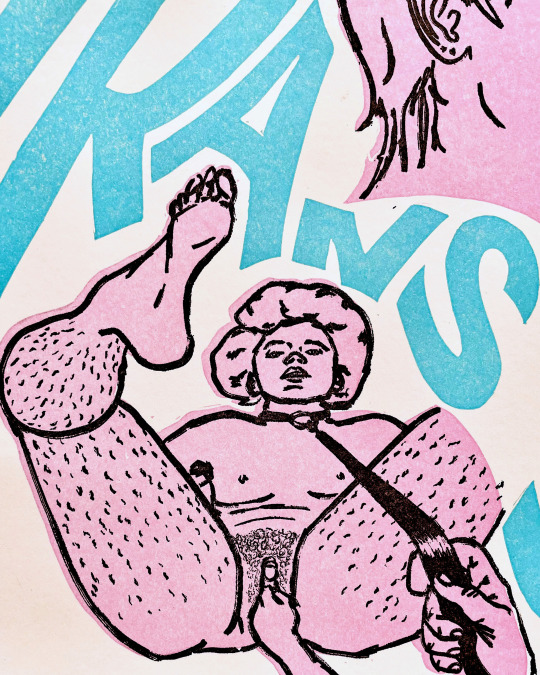
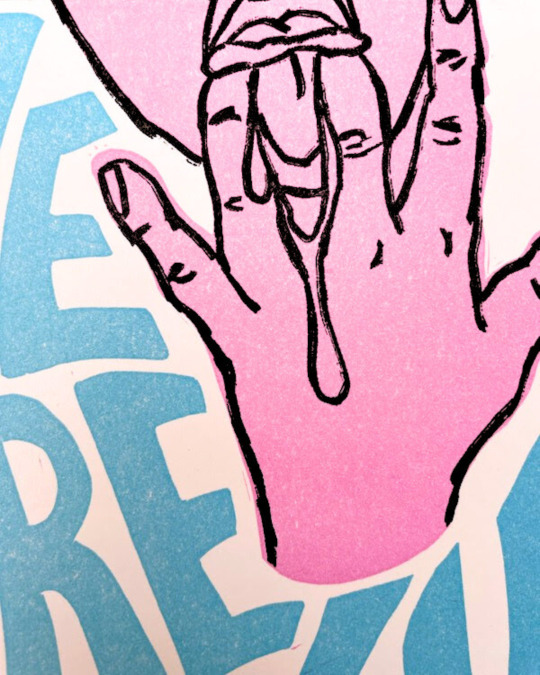
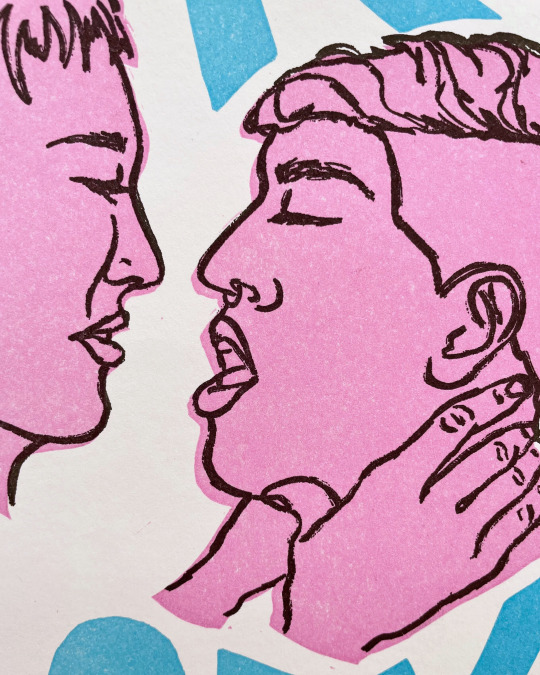
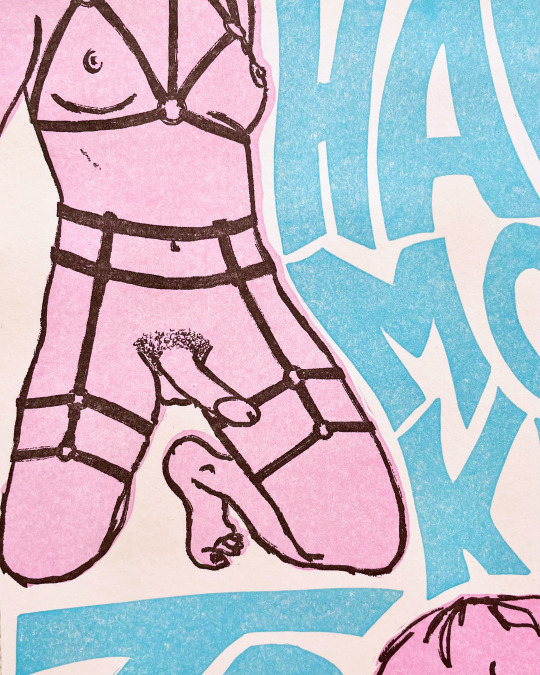
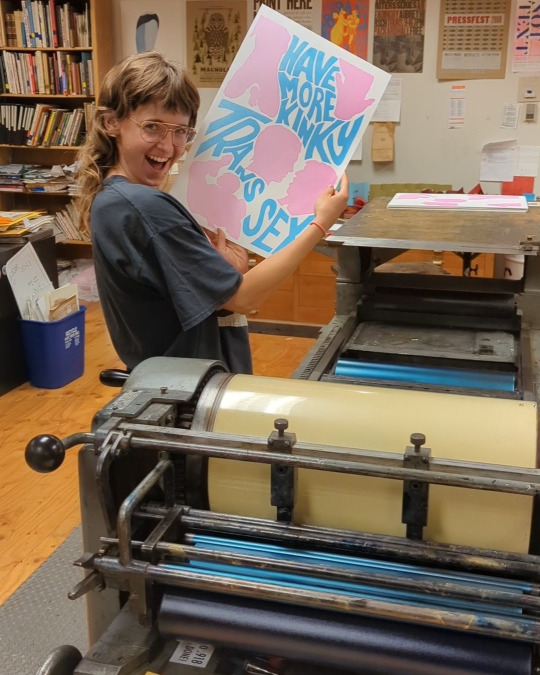
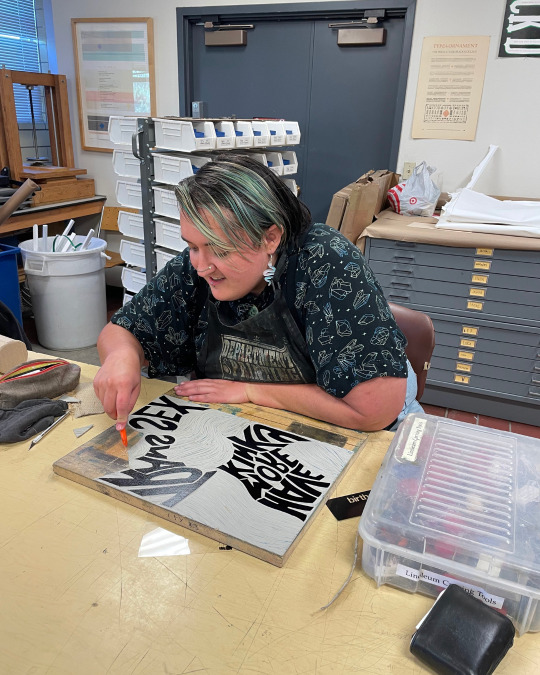

Can't believe this is the only social media site I can post the uncensored version of these prints on, but anyway...
This print is a collaborative project made utilizing linocut and photopolymer plate printing techniques. It emerged out of a conversation one day a few months ago in Nico's living room during a moment of particular grief and fear about the anti-trans hysteria we are living through. It is a straight-forward ode to our love for kinky trans sex and also an expression of our belief in continuing to live full, sexy, love-filled lives in the face of so much violence. You want to get rid of us? Still here, getting freakier.
~~~~
To see the full uncensored version, link in both of our bios!
The illustrations of the bodies were drawn by Celia Palmer and the text and linocut silhouettes were designed and carved by Nico Wilkinson. Nico and Celia printed the posters together on a Vandercook in the Press and Colorado College.
These posters are pay-what-you-can, $20-$50. (Please consider including an additional $5 for shipping!) To purchase your own, Venmo Celia at @celiapalmer with your name and address in the description. Posters will be shipped within two weeks, or are available for local pickup if you live in or near Colorado Springs - for local pickup, please include your phone number in the Venmo description.
The perfect gift for yourself, a friend, or a play partner!
#letterpress#t4t#printmaking#linocut#trans#trans sex#lgbtqia#queer art#queer prints#trans art#vandercook#printing press
187 notes
·
View notes
Text


21 February 2025 | Der Klubhaus
Spaceband Spaceman arrives at the Klubhaus from Fiddleink to observe lock-up strategies and printing procedures on the SP15.
5 notes
·
View notes
Note
Hello, I hope my message finds you well
I'm Asmaa from Gaza 🇵🇸❤️, I'm asking you for a small donation of 20€ to save our lives from Gaza 🙏
Can you donate to me and my family? Thanks to your donation we can achieve our goal as soon as possible ���
Your support and standing by us in this difficult time is everything to us
I would be very grateful if you donated to me and my family, thank you for your generosity in our time of need ❤️
https://gofund.me/b60fb34d
#Gaza#Palestine#free palestine#free gaza#artists#sharks#dinosaurs#fanfiction#neil gaiman#human rights#social justice#kirby#landscape#invader zim#x men#celebrity#vandercook#biscuits#nightmare before christmas#microwave
3 notes
·
View notes
Text

I have a dandy Vandercook press, newly acquired, and I am messing around with it. Two layers of wood type here. This is the bottom layer(s) for the first illustration in a new book.
0 notes
Text
#these are making a comeback so. teeheeeee#college friends if you were in any of melanie's classes: thats her model of vandercook. the one in the back room#grandpa max is god? i go to church now
52 notes
·
View notes
Text
only thing i miss about school was studio access to these crazy ass machines fml i shouldve spent every waking hour in the shop cranking shit out like where tf else am i supposed to have free reign of a press made in the 1900s
#eff#PUT ME BACK IN THE STUDIO I'LL GO CRAZIER THIS TIME I PROMISE.......#running relief prints off the letterpress was also so fucking efficient now they got me hand barening FUUUUUCK. not that i mind it.#but volume wise it was so much faster FML#my faaaavorite press was the vandercook 325 cause of the size but i also enjoyed the sp20. and i think universal 1 was the automatic?#its been a while i might be mixing up the names based off location on the shop floor >_<
11 notes
·
View notes
Text

Naomi Shihab Nye (نعومي شهاب ناي), I Still Have Everything You Gave Me, (original letterpress print), [from Fuel, BOA Editions, Rochester, NY, 1998(-2011)], Expedition Press, Seattle, WA, 2025, Printed on a 1950 Vandercook press from handset type, 1 ink / 1 pass, Type is Headline Med and Perpetua [© Naomi Shihab Nye]






#graphic design#typography#art#poetry#broadside#expedition press#naomi shihab nye#boa editions#1990s#2010s#2020s
54 notes
·
View notes
Text
[video description: process recording of letterpress printing a linoleum block print in a Vandercook flatbed press. in a flatbed press the relief printing material stands on its flat table and receives an even layer of ink from a carriage of rubber rollers passing over the surface; the paper is wrapped around a large cylinder which similarly rolls over the inked surface, pressing the ink into the paper. generally letterpress only allows one color to be printed at a time but in this illustration of a gecko, the iris of the eye is cleaned of ink before printing, hand-inked with a Q-tip for a spot of secondary color, and then printed. end description.]
etsy
(the lizard theme was an accident)
this is a block of my uncle's! he printed a couple copies for friends and family years ago. i asked if i could print more for the shop and he said yes; i asked if i could print them in jolly rancher colors and he said, i said…………you could…………print them……… which was not a no :)
arches 88, 14.75 inches square
#letterpress#letterpress printing#relief printing#printmaking#linocut#linoleum block#finished works#videos#process
15 notes
·
View notes
Text
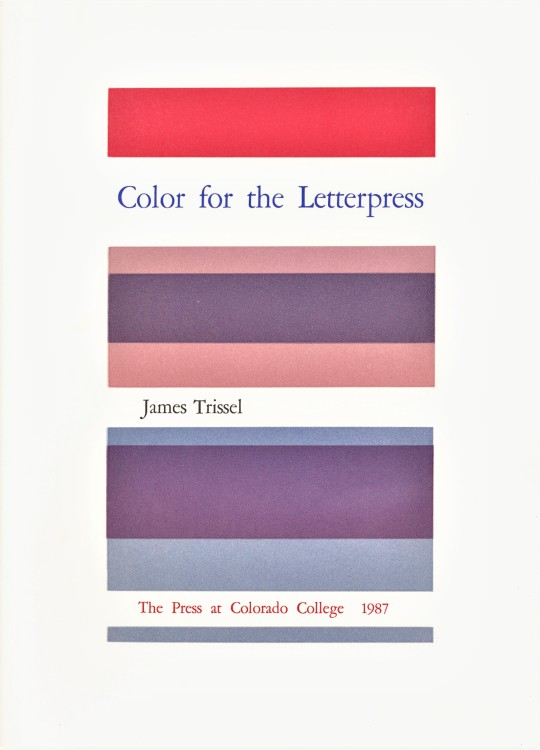
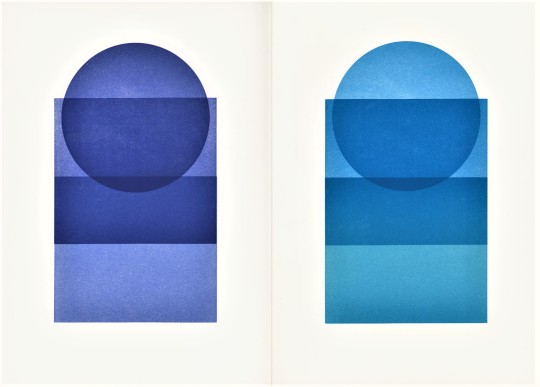
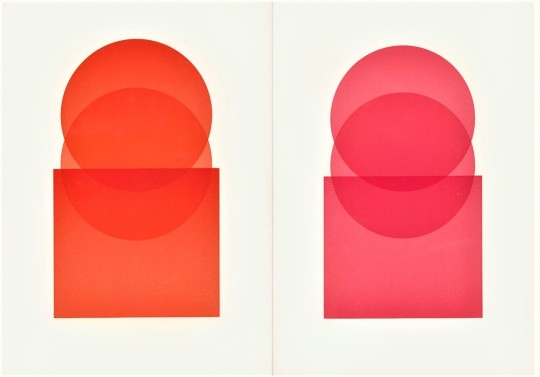
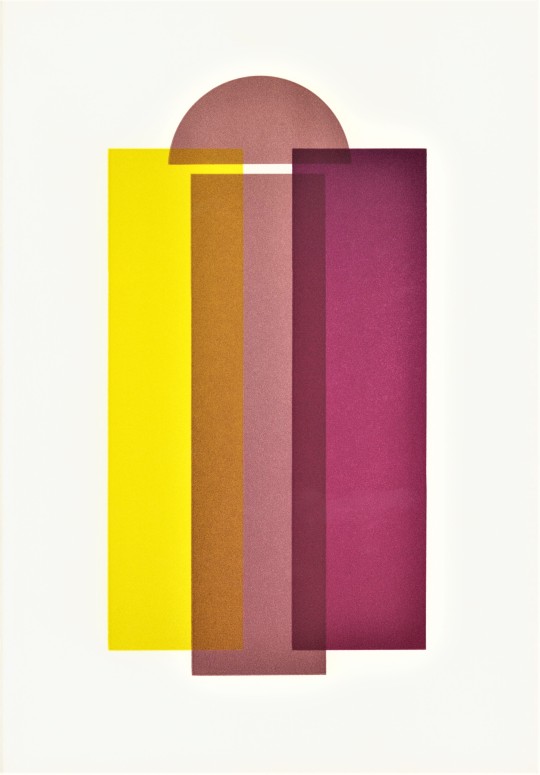
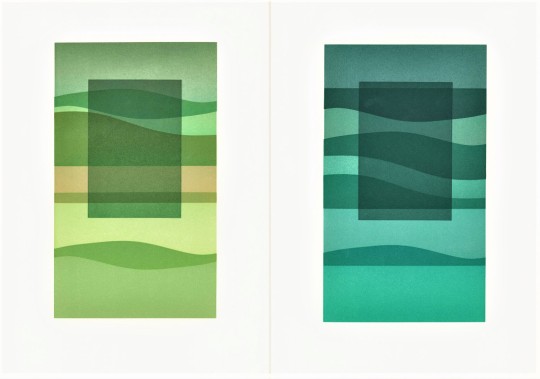
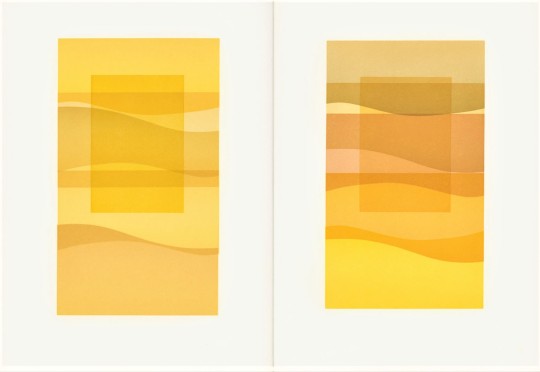
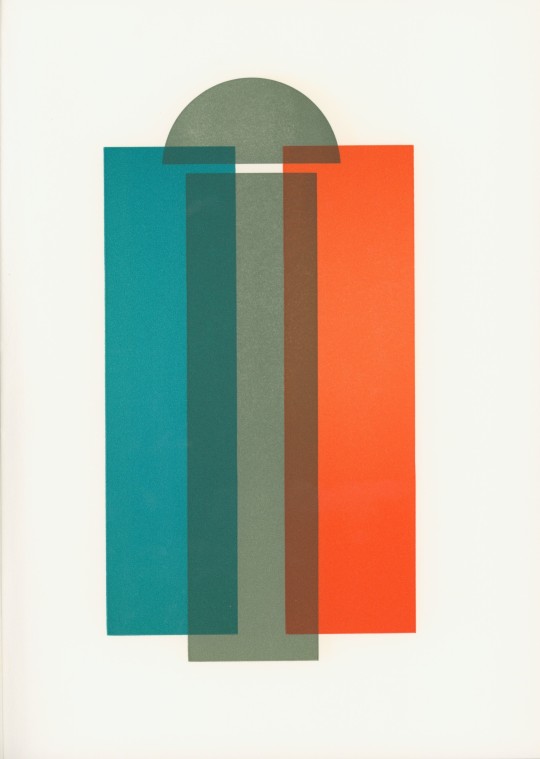
James Trissel's Color for Letterpress
After being away from UWM Special Collections for the first part of the Summer, I was delighted to spend some time looking through some of the gorgeous work we recently acquired from the estate of Dennis Bayuzick. I was particularly taken by Color for Letterpress, published in an edition of seventy-five by The Press at Colorado College in 1978. The book was designed and printed by founder of the press, Jim Trissel. Over two decades, Trissel raised the press to a level of excellence attained by only a handful of academic letterpresses in the United States.
Jim's son Ben, who worked beside him at the press, reflected on his father's exacting standards in a memorial essay shortly after his death in 1999: "I remember once abandoning the initial layout of the Color for Letterpress book because the registration was off by a 1/32 of an inch. He stopped the press run, reconfigured the book's enture structure, and printed it right."
Color for Letterpress was printed on a Vandercook Universal Power 3 press. Trissel used mostly lithographic inks on BFK Rives paper from Arches, which he describes in the introduction as "very white," and "dimensionally stable." The book consists of an introductory text and three sections of plates housed in a white acrylic case. The plates of the first section, The Quartered Spectrum, utilize single hues with variations in density and temperature. Families of Analogous Color, the second section, "contrasts hues by temperature but prints individual hues in closely related groups or families." The last grouping is called Six Complementary Pairs and shows contrasts in both hue and temperature. "The book is accordion-bound," writes Trissel, "to permit an easy display of the plates."
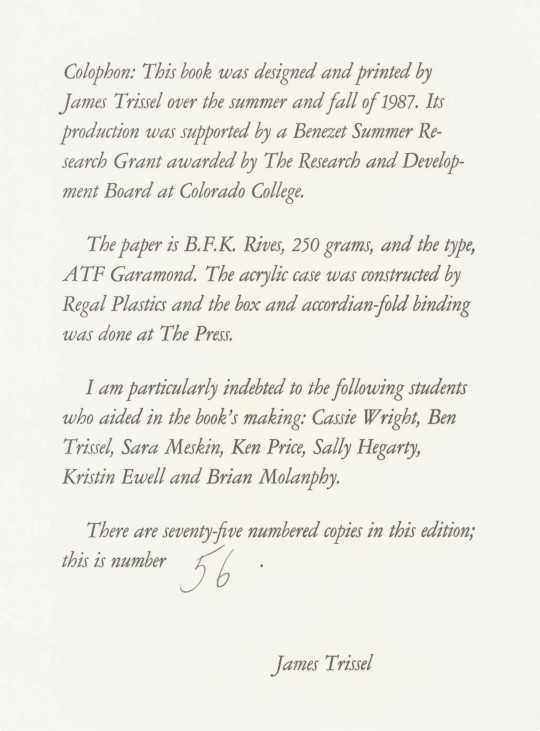
Check out more from the Collection of Dennis Bayuzick here.
Find more Decorative Sunday posts here.
-Olivia Hickner, Special Collections Graduate intern
#Decorative Sunday#Color For Letterpress#James Trissel#Jim Trissel#The Press at Colorado College#Letterpress Printing#Vandercook#Arches#BFK Rives#letterpress#fine press books#fine press printing#color theory#Dennis Bayuzick#olivia#decorative arts#decorative plates
69 notes
·
View notes
Note
hii! do you have any information about what garbo liked to read? like favorite books/poems/plays/authors?
hello! yes, i actually do have some information! garbo once told close friends that she didn’t read the books on her shelves - and yet, she was known to recite poems by walt whitman (leaves of grass), and one of her favorite poets was harriet löwenhjelm.
she had a vast and eclectic personal library. among her books were works by poets such as edna st. vincent millay, john keats, esaias tegnér, heinrich heine, omar khayyam, and the complete works of manuel and antonio machado.
as for novelists and authors, she owned books by selma lagerlöf, oscar wilde, f. scott fitzgerald, alexandre dumas, erich maria remarque, tolstoy (resurrection and anna karenina), dostoyevsky, emily brontë, hemingway, james joyce, shakespeare, thackeray, goethe (iphigenia), sylvia ashton-warner (spinster), knut hamsun (the women at the pump), arnold bennett (the pretty lady), garrett mattingly (catherine of aragon), pierre benoit (atlantida), john vandercook (empress of the dusk), vita sackville-west (saint joan of arc), louis verneuil (the fabulous life of sarah bernhardt), laurence housman (victoria regina), remy de gourmont (a night in the luxembourg), vincent sheean, john gunther (meet soviet russia: book one), ferenc molnár (the captain of st. margaret’s), ruth laughlin (the wind leaves no shadow), berthold viertel (fürchte dich nicht / don’t be afraid), nathaniel hawthorne (the scarlet letter), roman rolland (beethoven: the creator), glenn clark (i will lift up mine eyes, the man who tapped the secrets of the universe), hermann rauschning (the voice of destruction), and albert barnes & violette de mazia (the art of renoir).
she also had a deep interest in theatre and owned plays by henrik ibsen, vita sackville-west, louis verneuil, and laurence housman - in addition to her shakespeare collection.
these were some of the books, authors and poets i managed to gather - she certainly had many more. her literary taste seemed quite eclectic, moving between the spiritual and the worldly, the classical and the modern, the intimate and the historical. there was everything from lyrical poetry to treatises on art, biographies of tragic figures, dense russian novels, plays with complex female protagonists, books on gardening, spirituality, cooking, languages like english, swedish and french. many of the works had dedications from friends - carefully chosen gifts. there were also volumes on personal development, aesthetics, art history and rare editions. you can also find more information about the books garbo likely read and recited on the garboforever website.
12 notes
·
View notes
Text
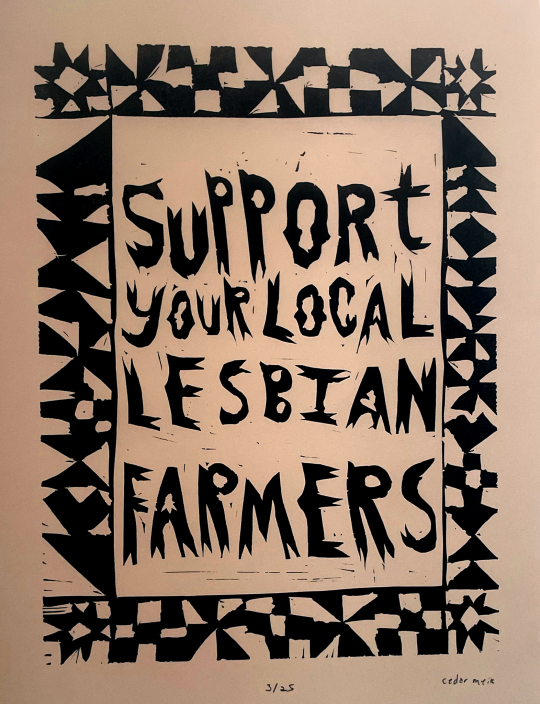
Support your local lesbian farmers!!
11”x15” linocut on paper. Printed on a vandercook #4. Edition of 25.
#butch lesbian#lesbian#they them lesbian#butch#trans artist#lesbian artist#lesbian printmaker#linocut#letterpress#relief print#printmaking#linoprint#block printing#lesbian farmer
53 notes
·
View notes
Text
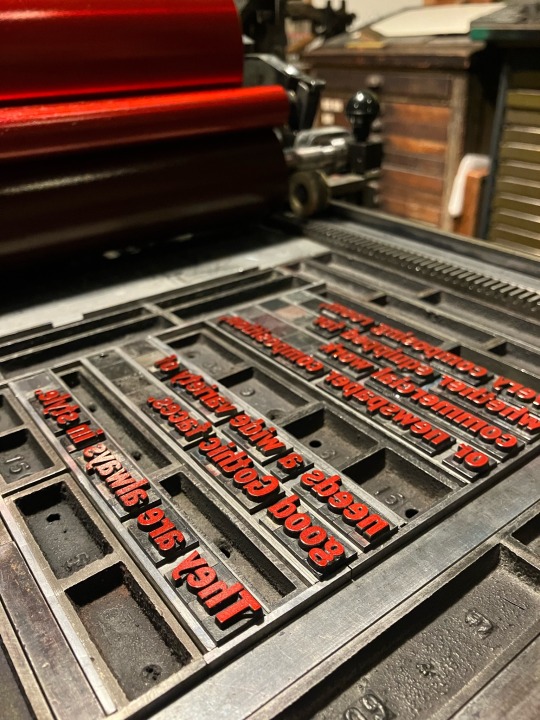
20 November 2023 | Der Klubhaus
More red ink for the stylish Franklin Gothic in Understanding This Book.
#utb#understanding#book arts#artists books#creative process#fine press#letterpress#metal type#vandercook#red ink#red#franklin gothic#love#style
10 notes
·
View notes
Text
LÉGENDES DU JAZZ
RICHARD DAVIS, LE CONTREBASSISTE QUI DANSAIT AVEC LES ÉTOILES
‘’He found freedom in the bass by pivoting between the earth and the stars.”
- Jason Moran
Né le 15 avril 1930 à Chicago, dans les Illinois, Richard Davis a grandi dans le South Side. Sa mère ayant perdu la vie en lui donnant naissance, Davis avait été adopté par Robert et Elmora Johnson. Davis avait amorcé sa carrière musicale aux côtés de ses frères, en jouant de la contrebasse dans le trio vocal familial qui était dirigé par un de ses cousins. Davis s’était rapidement familiarisé avec le jazz grâce à l’impressionnante collection de 78-tours de sa mère qu’il écoutait sans arrêt.
Mais malgré son intérêt pour la musique, ce n’est pas avant l’âge de quinze ans que Davis avait ressenti le besoin de fixer son choix sur un instrument en particulier. Davis étant plutôt timide et introverti, il n’était pas vraiment attiré par des instruments de premier plan comme le saxophone ou la trompette. À l’âge de quinze ans, Davis avait finalement fixé son choix sur la contrebasse, un instrument qui l’avait toujours fasciné. Davis expliquait: “I was just enthralled by the sound. The bass was always in the background and I was a shy kid. So I thought maybe I’d like to be in the background.”
Au DuSable High School, Davis avait étudié sous la direction du légendaire capitaine Walter Dyett. Très sévère, Dyett avait dirigé le Eighth Regiment Infantry Band dans la Illinois National Guard, ce qui en avait fait un farouche partisan de la discipline. Même s’il était très strict, Davis avait été très influencé par Dyett, qu’il avait décrit comme “the kind of teacher you dream about.” Même s’il avait formé de grands noms du jazz comme Nat King Cole et Dinah Washington, Dyett avait incité Davis à ne pas se limiter au jazz et à s’intéresser à tous les styles de musique. À Chicago, Davis avait également eu comme mentors les contrebassistes Wilbur Ware et Eddie Calhoun.
Au DuSable High School, Davis avait eu comme camarades de classe le futur saxophoniste Clifford Jordan et le futur chanteur de blues Bo Diddley (alors connu sous le nom d’Ellas McDaniel). Comme contrebassiste, Davis avait été particulièrement influencé par Oscar Pettiford, Jimmie Blanton, Slam Stewart et Milt Hinton.
Parallèlement à ses études, Davis avait été membre du Chicago Youth Symphony Orchestra (connu à l’époque sous le nom de Youth Orchestra of Greater Chicago). Davis avait d’ailleurs participé au premier concert de l’orchestre à l’Orchestra Hall de Chicago le 14 novembre 1947.
Après avoir décroché son diplôme du high school, Davis s’était inscrit à la VanderCook School of Music, où il avait éventuellement obtenu un baccalauréat en éducation musicale.
Parallèlement à ses études, Davis avait appris son métier ‘’sur le tas’’ en se produisant dans les clubs et les bars de Chicago. C’est d’ailleurs en jouant dans les clubs que Davis s’était lié d’amitié et avait commencé à travailler avec le pianiste Sonny Blount, qui se ferait bientôt connaître sous le nom de Sun Ra. Lors de leur premier rencontre, Blount avait dit à Davis: “I’m not gonna take you to the moon because you’re not ready yet.” Cette déclaration avait ouvert les yeux de Davis, qui n’avait pas tardé à découvrir que Blount était un mystique qui entretenait une vision très spirituelle de la musique. Blount avait d’ailleurs eu une influence déterminante sur l’évolution ultérieure de Davis. Ne délaissant pas pour autant ses études, Davis avait poursuivi son apprentissage de la contrebasse avec Rudolf Fahsbender du Chicago Symphony Orchestra.
DÉBUTS DE CARRIERE
En 1952, Davis s’était joint au trio du pianiste Ahmad Jamal, avec qui il avait joué durant deux ans. Après s’être lié d’amitié avec le pianiste Don Shirley, Davis s’était installé à New York en 1954. Il avait d’ailleurs enregistré avec Shirley un album en duo intitulé Tonal Expressions. Davis avait fait équipe avec Shirley jusqu’en 1956, lorsqu’il s’était joint au Sauter-Finegan Orchestra.
Au début, Davis avait trouvé la ville de New York plutôt intimidante. Il expliquait: “There was so much talent, and I was always feeling that a bass player who was already established in New York would see me carrying a bass and say, ‘Where you going, boy?’” Mais en dépit de ses craintes, Davis n’avait pas tardé à conquérir le Big Apple. Son habileté de contrebassiste et la facilité avec laquelle il pouvait lire la musique l’avaient rendu très populaire comme accompagnateur.
Très en demande dans les années 1960, Davis avait travaillé avec plusieurs petits groupes de l’époque, dont ceux d’Eric Dolphy, Jaki Byard, Booker Ervin, Andrew Hill, Elvin Jones et Cal Tjader. Il avait aussi collaboré à l’enregistrement de plusieurs albums-phares du jazz, dont Out to Lunch d’Eric Dolphy, Black Fire et Point of Departure d’Andrew Hill, Dialogue de Bobby Hutcherson, In ‘N Out de Joe Henderson, Essence de John Lewis, Let My Children Hear Music de Charles Mingus, A Night At The Vanguard de Kenny Burrell, Life Time de Tony Williams, The Song Book de Booker Ervin et Rip Rig and Panic de Rahsaan Roland Kirk.
Après un bref séjour avec le Sauter-Finegan Orchestra, sur la recommandation du batteur Roy Haynes, Davis s’était joint en 1957 à la section rythmique de la chanteuse Sarah Vaughan, avec qui il avait enregistré quatre albums (dont Swingin’ Easy, qui comprenait le classique “Shulie A Bop’’) et voyagé en tournée jusqu’en 1960. Davis, qui avait énormément apprécié son séjour avec la chanteuse, avait déclaré au cours d’une entrevue qu’il avait accordée en 2014:
��You could say I went to the University of Sarah Vaughan. She was so musically skilled. And playing with her brought me to play with her accompanist Jimmy Jones, whose knowledge of chords was phenomenal. Sarah was so musical she could improvise beautifully along with the changes he would play. And the great percussionist Roy Haynes was in that band too, and he had such an amazing concept of rhythm… Once you’ve proven yourself with musicians at that level, other vocalists start to call you, because they figure you must know something.”
Davis avait été particulièrement redevable à Vaughan de l’avoir aidé à améliorer son jeu à l’archet. Il expliquait: “Some of the first bass players used the bow to play the walking bass line. And I heard all of that coming up as a kid. Therefore, when you start to study books of bass methods, you start out with the bow no matter what your intentions are, so there must be some intertwining of what I heard as a kid, what I heard working with Sarah Vaughan, wanting to imitate those vocal sounds.”
Mais après avoir joué durant trois ans avec Vaughan, Davis avait ressenti le besoin de relever de nouveaux défis. C’est alors que Davis avait été contacté par Eric Dolphy, qui était alors l’étoile montante du jazz d’avant-garde. Davis raconte comment Dolphy l’avait approché: “He said, ‘What are you doing next week?’ I said, ‘Nothing.’ And he said, ‘Why don’t you go down to the Five Spot with me?’” Passionné par la musique classique contemporaine, Davis n’avait pas tardé à se lier d’amitié avec Dolphy, un multi-instrumentiste qui excellait tant au saxophone alto qu’à la clarinette basse et à la flûte.
Après s’être joint au groupe de Dolphy, Davis s’était immédiatement senti attiré par le free jazz (ou ‘’New Thing’’, comme certains l’appelaient à l’époque). Comme Davis l’avait expliqué au cours d’une entrevue accordée en 2001: “Limiting yourself to a particular set of notes and chords is in a sense being a slave to the powers that be. We were resisting being imprisoned by chord changes, trying to free ourselves from the restrictions of scales and rhythms. Some people call this free music. Some of us called it our music. Unrestricted, indefinable, and free.”
Davis avait enregistré deux albums avec Dolphy: Iron Man (1963) et Out To Lunch! (1964), un album qui est aujourd’hui considéré comme un classique du jazz d’avant-garde. Dolphy, qui ne tarissait pas d’éloges pour l’originalité de Davis, écrivait dans les notes de pochette de l’album: “Richard doesn’t play the usual bass patterns. He plays rhythm with his lines. He leads you somewhere else.”
En plus des deux albums déjà cités, on peut entendre Davis sur les albums live de Dolphy enregistrés au club Five Spot, ainsi que sur différentes sessions publiées après la mort tragique de ce dernier en 1964. Un coffret publié récemment sous le titre de Musical Prophet: The Expanded 1963 New York Studio Sessions comprend un enregistrement de la pièce “Iron Man”, une pièce que Dolphy avait composée en l’honneur de Davis. Le coffret inclut également des pièces que Dolphy et Davis avaient enregistrées en duo, dont le classique ‘’Come Sunday’’ de Duke Ellington. Au cours de cette période, Davis avait également travaillé avec d’autres musiciens d’avant-garde comme le vibraphoniste Bobby Hutcherson, le batteur Tony Williams, et surtout le pianiste Andrew Hill, avec qui il avait enregistré sept albums de 1963 à 1969, dont le classique Point Of Departure (1964).
En 1966, Davis avait été un des membres fondateurs du Thad Jones/Mel Lewis Orchestra, dont il avait fait partie jusqu’en 1972 et qui se produisait tous les lundis soirs au légendaire Village Vanguard de New York.
Commentant le travail de Davis sur la pièce “Three and One’’ que Jones avait arrangée spécialement pour mettre en valeur les talents du contrebassiste, le chef d’orchestre et compositeur Darcy James Argue avait précisé: “Davis plays the nimble melody along with the horns, before dropping into steady, buoyant walking lines to drive the sax soli and horn solos. Then, Davis solos with gestural abstraction, like a Jackson Pollock action painting come alive.” Au cours de cette période, Davis avait également joué avec Don Sebesky, Oliver Nelson, Frank Sinatra, Miles Davis, Johnny Hodges, Dexter Gordon, Joe Henderson et Ahmad Jamal.
Mais le jazz ne nourrissant pas toujours très bien son homme, Davis avait été contraint d’accepter certains contrats ‘’alimentaires’’ afin de pouvoir assurer sa subsistance. Il avait même conçu des jingles publicitaires et travaillé sur des dizaines de projets ‘’mainstream’’, enregistrant notamment avec la chanteuse de R & B Ruth Brown et le percussionniste de jazz latin Willie Bobo. Il avait également enregistré avec plusieurs musiciens pop et rock. Davis avait notamment fait des apparitions sur les albums Smile de Laura Nyro, Watertown de Frank Sinatra, Something So Right de Paul Simon, Astral Weeks de Van Morrison, Greetings From Asbury Park, N.J. et Born to Run de Bruce Springsteen et At Seventeen de Janis Ian.
Le succès que Davis avait remporté avec l’album Astral Weeks lui avait d’ailleurs apporté d’autres contrats avec des artistes comme Rickie Lee Jones, Bonnie Raitt, Judy Collins, Buffalo Springfield, Carly Simon et Barbra Streisand. Commentant l’enregistrement de l’album, Davis avait précisé: “Some people are real disillusioned when I tell them about making the record. People say, ‘[Morrison] must have talked to you about the record and created the magic feeling that had to be there….’ To tell you the truth, I don’t remember any conversations with him. He pretty much kept to himself. He didn’t make any suggestions about what to play, how to play, how to stylize what we were doing.” De son côté, le producteur Lewis Merenstein avait déclaré: “[F]or me, it was Richard all the way. Richard was the soul of the album.” Quant au critique Griel Marcus du magazine Rolling Stone, il avait qualifié le travail de Davis de ‘’greatest bass ever heard on a rock album.”
En 1967, Davis était devenu un artiste de premier plan en enregistrant Heavy Sounds, une collaboration avec l’ancien batteur de John Coltrane, Elvin Jones. L’album avait permis à Davis de déployer toute l’étendue de sa virtuosité, notamment dans le cadre d’une remarquable version du standard “Summertime’’ de George Gerswhin. Mais il avait fallu attendre encore deux ans pour que Davis enregistre un premier album comme leader, Muses For Richard Davis, une session de jazz post-bop enregistrée pour l’étiquette allemande MPS. Mais s’il avait fallu du temps à Davis pour enregistrer un premier album sous son nom, il s’était bien repris depuis et avait gravé trente albums comme leader ou comme co-leader de 1967 à 2007.
À la fin des années 1960 et au cours des années 1970, Davis avait également été membre du New York Bass Violin Choir. Dirigé par le contrebassiste Bill Lee (le père du réalisateur Spike Lee), le groupe comprenait également d’autres virtuoses de cet instrument comme Ron Carter, Milt Hinton et Sam Jones.
Durant sa carrière, Davis avait aussi joué de la musique classique avec des chefs d’orchestre de renommée mondiale comme Igor Stravinsky (qui le considérait comme son contrebassiste préféré), Leonard Bernstein, George Szell, Pierre Boulez, Leopold Stokowski et Gunther Schuller. Davis, qui détestait les étiquettes, avait commenté ainsi son habileté à se produire dans différents types de musique: “Duke Ellington always said there’s no difference between jazz and classical. He didn’t classify any genres. To him, there were only two kinds of music: It’s either good or bad. I’m with Duke Ellington on that.”
DERNIERES ANNÉES
Après avoir vécu à New York durant vingt-trois ans, Davis était déménagé au Wisconsin en 1977 pour devenir professeur à l’Université de Wisconsin–Madison, où il avait enseigné la contrebasse, l’histoire du jazz et l’improvisation durant plus de quarante ans. Parmi ses étudiants, on remarquait William Parker, David Ephross, Sandor Ostlund, Hans Sturm, Alex Kalfayan, Ryan Maxwell et Karl E. H. Seigfried. Davis explique comment il avait été approché pour enseigner à Madison: “I got a call offering me a job at the university in Madison because they didn’t have a bass teacher on campus.’’ Davis n’ayant jamais entendu parler de cette université, il avait interrogé son entourage pour savoir où l’université se trouvait. Il précisait: “I asked around if anyone had heard of the place because this school kept calling me. Martin Luther King, Jr. talked about the importance of teaching others, and I had always wanted to teach young people. I thought maybe it was time.”
En raison de son travail d’enseignant, Davis avait dû réduire sensiblement le nombre de ses sessions d’enregistrement et de tournées. À l’instar de son mentor Walter Dyett, Davis avait rapidement acquis la réputation d’être un professeur très sévère qui accordait également d’importance à la discipline. Il expliquait: “I teach character. That’s the most important thing for me — follow-through and hard work. The world is not waiting on you, and there’s tons of talent out there.” Décrivant sa passion pour l’enseignement, Davis avait précisé: “I love teaching. I believe you should share what you have.” Le premier étudiant diplômé de Davis, Peter Dominguez, avait commenté ses débuts dans l’enseignement de la façon suivante: “He came from New York and he had that heavy New York accent – and it was hard to understand him – but he’d always do this thing where he’d grab your bass, anything that you were playing, and he would immediately tear it up. I mean, he would just play it flawlessly and he’d hand it back to you. He’d always say, ‘Yeah, and I don’t even know your bass.’ And you’d just go, ‘Oh…’ How do you respond to that? But it really taught me that I had to get down to business.”
Parallèlement à son travail de professeur, Davis s’était également distingué pour son implication sociale, notamment en participant à la création d’institutions combattant le racisme. L’engagement de Davis dans la lutte contre le racisme était directement lié à la discrimination qu’il avait vécue lors de ses tentatives visant à s’établir comme musicien classique. Davis expliquait:
“My environment with race issues started the day I was born. You’re born with dark skin, and that itself brings on attitudes of other people who are not dark-skinned to see you as someone to be oppressed and not to be given equal chances in society. So that is something that is permanent [...]. I was 18 years old and I could play any and all of the European classical music, but you weren’t allowed to participate in the symphony orchestra because there were racial issues and prejudices. They didn’t want to see you.”
En 2000, Davis avait fondé le chapitre local de l’Institute for the Healing of Racism, un organisme dont il avait été le président et qui avait pour but de favoriser l’harmonie interraciale par l’entremise d’échanges entre les différentes communautés culturelles.
Comme Davis l’avait expliqué au cours d’une entrevue qu’il avait accordée en 2010: “One of the big problems here is racism — racial profiling, racism, from other students towards black students and teachers and administrators alike. And I couldn't live with myself if I would not intervene and do something, and that’s what I’ve got. I had a daughter of 28, and I was setting a role model for her to do something.” En 1998, Davis avait également fondé le Retention Action Project (RAP) afin d’améliorer le taux de graduation des étudiants de couleur. Au cours des années, le R.A.P. avait réussi à faire venir à l’université les plus grands conférenciers et activistes, dont Peggy McIntosh, Jane Elliott, Francie Kendall, Nathan Rutstein, Victor Lewis, Hugh Vasquez et Allan G. Johnson. Davis avait aussi animé des ateliers. Un de ses ateliers avait pour titre ‘’Racial Conditioning: The Oneness of Humankind.’’
Davis avait aussi encouragé une plus grande diversité parmi le corps enseignant, qui était composé à 97% de professeurs blancs au moment où il s’était joint à l’université en 1977. Très intéressé par le développement de la relève, Davis avait également co-fondé en 1993 avec son ancien étudiant Peter Dominguez la Richard Davis Foundation for Young Bassists. La fondation attirait annuellement une centaine de jeunes musiciens de trois à dix-huit ans. Très impliqué dans la promotion de la justice sociale, Davis était toujours prêt à partager sa vision, sa résidence et ses ressources de façon à créer un environnement permettant à chacun de vivre dans la paix et la dignité. Davis avait également fondé à Madison un chapitre de l’Institute for the Healing of Racism, Inc. Davis a pris sa retraite de l’enseignement en 2016, même s’il avait continué d’être impliqué dans sa fondation.
En 1986, Davis s’était produit au légendaire club Sweet Basil de Greenwich Village avec un groupe qui comprenait le batteur Freddie Waits. Dans son compte rendu du concert, le critique Robert Palmer du New York Times avait commenté: “The relaxed, slightly behind-the-beat swing typical of so many jazz rhythm sections is not for them. Their accents fall right up on top of the beat, and they vary their springy forward momentum with rhythmic whirlpools and rapids and an explosive sense of dynamics.” À la fin des années 1980, Davis avait également fait partie des membres fondateurs du groupe New York Unit, un trio qui comprenait le pianiste John Hicks et le batteur Tatsuya Nakamura. Le trio avait enregistré huit albums pour des compagnies japonaises jusqu’en 1998.
En mai 2000, Davis avait publié un CD intitulé The Bassists: Homage to Diversity. Enregistré au Japon, l’album avait pour but d’exprimer l’unicité de l’humanité.
En 2016, Davis s’était rendu à Paris, en France, afin de participer à un hommage à John Coltrane avec Archie Shepp. Faisant le bilan de sa carrière en 2019, Davis s’était dit satisfait du travail accompli. Il avait précisé: “I’ve done some great things. I’ve had some phenomenal associations with some great composers, conductors, colleagues and the whole bit.”
Richard Davis est mort le 6 septembre 2023 à Madison, au Wisconsin, à l’âge de quatre-vingt-treize ans. Très malade, Davis avait été hospitalisé durant deux ans dans une maison spécialisée pour personnes âgées. Les causes exactes de sa mort n’avaient pas été précisées. Davis laissait dans le deuil une fille, Persia. Au moment de sa mort, Davis travaillait sur la rédaction de son autobiographie. C’est sa fille Persia qui avait annoncé le décès de Davis dans un communiqué. Remerciant la communauté de Madison de son soutien, Persia avait commenté: “We appreciate all the love and support the community has shown him over the years.’’ Persia, qui avait créé une page web en hommage à son père, avait ajouté: ‘’Richard touched the lives of thousands and will be missed by friends, family, fans, students, and colleagues around the world.”
À la demande de Davis, il n’y avait eu aucun mémorial ni funérailles publiques. L’animateur de jazz Chuck France avait rendu hommage à Davis le 20 septembre sur les ondes de la station de radio WORT.
Rendant hommage à Davis après sa mort, le pianiste Ethan Iverson avait déclaré: “The room became much larger when Richard Davis unpacked his instrument.” Un autre collaborateur de Davis, le pianiste Jason Moran, avait salué “the way he found the space in the bass line. Instead of ‘walking’ a bass line, Davis seems to ‘chart’ it. Like an astronomer charting the sky.’’ Moran avait ajouté: “In that way, he found freedom in the bass by pivoting between the earth and the stars.” Le dernier album de Davis, un enregistrement en duo avec le pianiste Junior Mance, était intitulé Blue Monk. L’album avait été publié exclusivement au Japon en 2009.
Lauréat de nombreux prix, Davis a été élu ‘’Jazz Master’’ par la National Endowment for the Arts en 2014. Davis a également remporté un Hilldale Award pour souligner son travail d’enseignant. Le prix lui avait été remis par l’ancienne chancelière de l’Université Madison, Donna Shalala. En 2000, le Club Rotary de Madison avait aussi décerné à Davis un Manfred E. Swarsensky Humanitarian Award. L’année suivante, le gouverneur de l’État du Wisconsin lui avait attribué le Governor’s of Wisconsin Arts Award. En 2003, Davis avait également remporté le Reverend Dr. Martin Luther King, Jr. Humanitarian Award. Décerné annuellement par la Cité de Madison, le prix lui avait été remis par la mairesse Susan J.M. Bauman dans le cadre du 18e anniversaire de la mort de King. En 2008, Davis s’était également vu attribuer un prix MAMA (Madison Area Music Award Michael St. John Lifetime Achievement Award). L’année suivante, l’Université de Madison avait attribué à Davis un Exceptional Service Award. La même année, la Wisconsin Historical Society lui avait décerné un Spencer Tracy Award for Distinction in the Performing Arts.
Davis est également récipiendaire de plusieurs doctorats honorifiques, dont un du Edgewood College de Madison, en 1998. En 2018, la Cité de Madison a aussi renommé une rue en son honneur. Davis avait également remporté le titre de meilleur contrebassiste dans le cadre de sept sondages consécutifs des critiques du magazine Down Beat de 1967 à 1974. Quant au magazine Rolling Stone, il avait classé Davis au 34e rang des 50 plus grands bassistes de tous les temps.
Davis a collaboré à plus de six cents albums au cours de sa carrière, en plus d’en diriger une douzaine comme leader, dont le classique Heavy Sounds, enregistré avec le batteur Elvin Jones en 1967. Davis a travaillé avec de nombreuses sommités du jazz au cours de sa carrière, dont Eric Dolphy, Sonny Stitt, Oliver Nelson, Ahmad Jamal, Sarah Vaughan, Miles Davis, Charles Mingus, Johnny Hodges, Dexter Gordon, Joe Henderson, Milt Hinton, Bobby Hutcherson, John Hicks, Tony Williams, John Lewis, Jaki Byard, Kenny Burrell, Ron Carter, Jason Moran, Roy Haynes, Booker Ervin, Louis Armstrong, Dizzy Gillespie, Pharoah Sanders, Archie Shepp, Andrew Hill, Elvin Jones et Cal Tjader. Davis s’est également produit dans les plus grandes salles à travers le monde, que ce soit au Japon, en Europe, en Russie, en Amérique du Sud, en Europe, à Hong Kong ou en Israël.
Commentant la polyvalence de Davis comme musicien, le contrebassiste et professeur Rufus Reid lui avait rendu hommage en ces termes: “Richard has played in every musical setting you could imagine. Whether it be performing in a symphonic orchestra, recording jingles, recording jazz records, and then playing until dawn in a club in the bowels of The Village in New York… and he might be doing all of that in one day.” Saluant la contribution de Davis au monde du jazz et à la lutte contre le racisme, le directeur éditorial de WISC-TV, Neil Heinen, écrivait dans le magazine Spectrum:
“As one of the world’s premier bass players, Davis’s music has touched the lives of countless fans, and his teaching has inspired generations of students in the classroom as well as with the Richard Davis Foundation for Young Bassists, Inc., which provides musical instruction for financially challenged youth. While the jazz master and professor could’ve ended his renowned biography there, his passion for social justice, for the healing of racism, has changed the lives of those who have accepted his invitation to open their hearts, minds and spirits to the history and pathology of racism within.”
Le contrebassiste William Parker, qui avait étudié avec Davis au cours de sa jeunesse à New York, ne tarissait pas non plus d’éloges au sujet du talent de son collègue. Parker avait déclaré: “Richard Davis was a beautiful musician and human being. He reminded me of an African king, regal and strong. I praise him not because he could play both classical and jazz. I applaud him because the brother had a big, poetic sound full of freedom.” Décrivant Davis comme un musicien et professeur très exigeant qui incitait ses collaborateurs à élever la qualité de leur jeu et à toujours donner le meilleur d’eux-mêmes, le batteur Victor DeLorenzo avait précisé: “And, I’ll never forget, Richard was talking with me one time and he said, ‘Victor, I’m glad that you’re a part of this group, but I have to ask you…what is it that you do?’ He was referring to me playing on stage because I was playing with brushes and it was kind of quiet – what I was doing – and he couldn’t really hear me. Because there was another drummer and another percussionist featured in the group. So, he was honestly asking, ‘What is it that you do?'”
De l’avis de DeLorenzo, si Davis était un aussi grand musicien, c’était parce qu’il cherchait constamment à apprendre et à s’améliorer. DeLorenzo avait ajouté: “He was a gifted musician in that he was a very studied musician and had a great knowledge of the jazz idiom. But also, he was known and respected as a musician that could play with any other musician. He just had that wide-open kind of a personality.”
En plus de sa carrière de musicien et de son travail de professeur, Davis était également un grand passionné d’équitation. Davis avait commencé à s’intéresser aux chevaux à l’âge de neuf ans lorsqu’il avait obtenu un travail à temps partiel dans une écurie de Chicago aux côtés de son camarade de classe Bo Diddley. Davis avait même participé à un concours de dressage.
©- 2025, tous droits réservés, Les Productions de l’Imaginaire historique
SOURCES:
FORDHAM, John. ‘’US jazz bassist who worked with Van Morrison and Sarah Vaughan and later became a professor of bass at Wisconsin University.’’ The Guardian, 27 septembre 2023.
HENKIN, Andrey. ‘’Richard Davis, Gifted Bassist Who Crossed Genres, Dies at 93.’’ New York Times, 11 septembre 2023.
‘’Richard Davis.’’ Wikipedia, 2024.
2 notes
·
View notes
Text

Printed some new “business cards” today.
More photos + information about the process below the cut.



I’ve never mentioned it in here before, but I work as an assistant in a letterpress print shop!
Letterpress printing is the process of assembling a body of text out of individual pieces of lead type that each carry the raised (mirror) image of a single letter. This forme is then put on a printing press, inked, and then pressed against a piece of paper to transfer the ink to the page.
I printed these on a Vandercook Proofing Press, which was made in the 1960s. It has a motor, and auto-inks the forme, which is a huge time saver.
And the typeface I used is Garamond 12pt.
#lmk if you have questions about the process!#i love talking about printing <3#my art#my prints#printing#letterpress#printing press#typesetting
13 notes
·
View notes